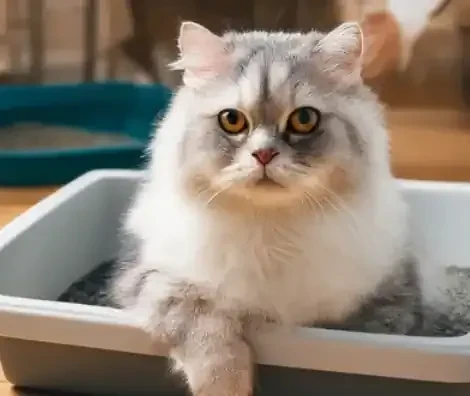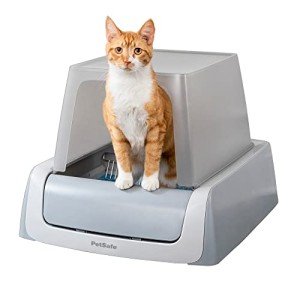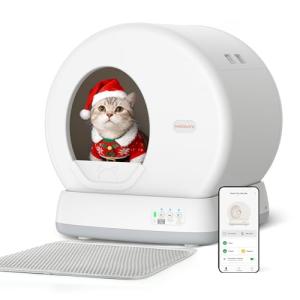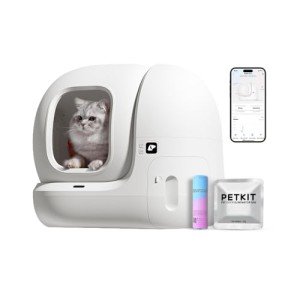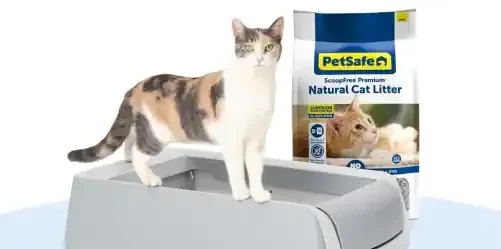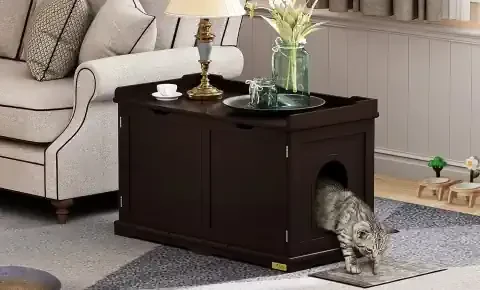Introduction
The Cat Litter Box is an essential component of feline care, profoundly impacting both the well-being of cats and the harmony within their human households. Understanding its pivotal role necessitates an exploration into its evolution, significance, and the critical factors influencing its selection.
Importance of the Cat Litter Box in Cat Care
The Cat Litter Box serves as a cornerstone in maintaining a cat's physical and psychological health. From their earliest domestication, cats have retained their instinctual need for a designated elimination area. Failure to provide an appropriate litter box can lead to stress, behavioral issues, and even health problems.
Beyond mere convenience, the litter box symbolizes a cat's territory—a safe haven where they feel secure to perform their natural bodily functions. Cats are notoriously fastidious creatures, and a clean, accessible litter box is paramount to their satisfaction and overall contentment.
Furthermore, the presence of a well-maintained litter box fosters a hygienic environment, minimizing the risk of odor buildup and the spread of diseases associated with unsanitary conditions. By attending to their litter box needs, cat owners uphold their responsibility to ensure the health and welfare of their beloved companions.
Evolution of Litter Box Designs
The evolution of the Cat Litter Box mirrors the evolving relationship between humans and their feline counterparts. Early iterations consisted of rudimentary trays filled with sand or soil, reflecting a basic understanding of cats' need for a designated elimination area.
As the bond between humans and cats deepened, so too did the innovation surrounding litter box design. From the introduction of covered and hooded variants to the advent of self-cleaning and automatic models, each iteration aimed to address specific concerns related to odor control, privacy, and convenience.
Today, modern litter boxes encompass a spectrum of designs, materials, and functionalities, catering to the diverse needs and preferences of both cats and their owners. From minimalist trays to multifunctional furniture pieces, the evolution of litter box design continues to adapt to the ever-changing landscape of pet care.
Significance of Choosing the Right Litter Box
Selecting the right Cat Litter Box is a decision not to be taken lightly, as it directly influences the well-being of both cats and their human companions. Factors such as size, material, accessibility, and maintenance requirements must be carefully considered to ensure the optimal fit for both the cat and its environment.
A well-chosen litter box promotes proper elimination habits, reduces the risk of litter box aversion, and enhances the overall quality of life for both cats and their owners. Moreover, investing in a high-quality litter box demonstrates a commitment to providing the best possible care for one's feline companion—a gesture that does not go unnoticed by the discerning cat.
In essence, the significance of choosing the right Cat Litter Box extends far beyond mere functionality—it speaks to the bond between human and feline, the commitment to responsible pet ownership, and the mutual respect that defines this enduring relationship.
Traditional Litter Box Designs
Traditional litter box designs serve as the foundation upon which the modern cat care industry has been built. While simple in concept, these designs have undergone subtle refinements over the years to address the evolving needs of both cats and their owners.
Basic Tray Style Litter Boxes
The basic tray style litter box represents the quintessential image of cat litter containment. Consisting of a rectangular or square-shaped container with low sides, these litter boxes offer simplicity and accessibility. Their open design allows for easy entry and exit, making them suitable for cats of all ages and sizes.
While lacking in frills, basic tray style litter boxes excel in their practicality and ease of use. Their uncomplicated design facilitates straightforward cleaning and maintenance, requiring nothing more than regular scooping and occasional replacement of litter.
Despite their simplicity, basic tray style litter boxes remain a popular choice among cat owners due to their affordability, versatility, and effectiveness in fulfilling the basic needs of feline companions.
Covered Litter Boxes: Pros and Cons
Covered litter boxes represent a natural evolution from their open counterparts, offering an added layer of privacy and odor control. Enclosed within a dome or hood, these litter boxes provide cats with a secluded space to carry out their elimination activities away from prying eyes.
One of the primary benefits of covered litter boxes is their ability to contain odors more effectively than open trays. The enclosed design helps to trap unpleasant smells, ensuring a more pleasant environment for both cats and their owners.
However, covered litter boxes are not without their drawbacks. Some cats may find the confined space restrictive or intimidating, leading to reluctance or refusal to use the box. Additionally, the enclosed nature of these litter boxes can trap humidity, potentially exacerbating issues such as clumping and sticking.
Hooded Litter Boxes: Benefits and Drawbacks
Hooded litter boxes offer a compromise between open trays and fully enclosed designs, providing cats with a sense of privacy while still allowing for adequate ventilation and airflow. These litter boxes feature a removable hood or cover that can be easily lifted for cleaning and maintenance.
One of the key benefits of hooded litter boxes is their ability to contain litter scatter and reduce tracking. The hooded design helps to confine litter particles within the box, minimizing mess and simplifying cleanup.
However, hooded litter boxes may not be suitable for all cats. Some felines may feel confined or trapped by the hood, leading to avoidance behavior or anxiety. Additionally, the enclosed space can trap odors if not properly maintained, necessitating diligent cleaning and regular ventilation.
Self-Cleaning Litter Boxes: Efficiency and Functionality
Self-cleaning litter boxes represent the pinnacle of litter box innovation, offering unparalleled convenience and automation in cat care. These advanced systems utilize sensors, motors, and specialized litter substrates to automatically detect and remove waste, leaving behind a clean and odor-free environment.
One of the primary advantages of self-cleaning litter boxes is their ability to reduce the frequency of manual scooping and cleaning. By automating the process of waste removal, these litter boxes alleviate the burden on cat owners and ensure a consistently hygienic litter box environment.
However, self-cleaning litter boxes may come with a higher price tag compared to traditional designs, making them a significant investment for some pet owners. Additionally, the mechanical components of these systems require regular maintenance and cleaning to prevent malfunctions and ensure optimal performance.
Despite these considerations, self-cleaning litter boxes offer unparalleled convenience and efficiency in cat care, making them a popular choice among busy pet owners seeking to streamline their litter box maintenance routine.
Modern Innovations in Litter Boxes
The landscape of cat litter boxes has been transformed by a wave of modern innovations, ushering in an era of unprecedented convenience, functionality, and style. From top entry designs to smart technology integration, these modern litter boxes represent the cutting edge of feline care.
Top Entry Litter Boxes: Advantages for Containment
Top entry litter boxes reimagine the traditional litter box design by introducing a novel approach to containment and privacy. Featuring a lid or cover with a small opening on top, these litter boxes encourage cats to enter and exit through the top, minimizing litter scatter and tracking.
One of the primary advantages of top entry litter boxes is their ability to contain litter within the box, preventing it from being kicked or tracked outside. The enclosed design helps to confine litter particles and odors, resulting in a cleaner and more hygienic environment.
Additionally, top entry litter boxes offer an added layer of privacy for cats, providing them with a secluded space to carry out their elimination activities away from prying eyes. The elevated entry point also makes it more challenging for dogs and other pets to access the litter box, reducing the risk of unwanted interference.
Automatic Litter Boxes: Convenience and Maintenance
Automatic litter boxes revolutionize the chore of litter box maintenance by automating the process of waste removal and cleaning. These innovative systems utilize sensors, motors, and specialized mechanisms to detect and dispose of waste, leaving behind a clean and odor-free litter box environment.
One of the primary benefits of automatic litter boxes is their ability to reduce the frequency of manual scooping and cleaning. By automating the process of waste removal, these litter boxes alleviate the burden on cat owners and ensure a consistently hygienic litter box environment.
Additionally, automatic litter boxes help to minimize odor buildup by promptly removing waste from the litter box, resulting in a fresher and more pleasant-smelling environment for both cats and their owners. Some models even feature carbon filters or other odor control mechanisms to further enhance odor control.
Litter Box Furniture: Blending Functionality with Home Décor
Litter box furniture combines form and function to create discreet and stylish solutions for litter box containment. These innovative designs conceal the litter box within a piece of furniture, such as a cabinet or bench, providing cats with a private and secluded space to carry out their elimination activities.
One of the primary benefits of litter box furniture is its ability to integrate seamlessly into the home environment, allowing cat owners to maintain a clean and stylish living space without sacrificing their pet's comfort or well-being. These pieces often feature cleverly disguised entry points and ventilation systems to ensure optimal functionality while minimizing odor and mess.
Additionally, litter box furniture helps to address common aesthetic concerns associated with traditional litter boxes, such as unsightly litter scatter and tracking. By concealing the litter box within a piece of furniture, cat owners can enjoy a cleaner and more visually appealing living space while still providing their feline companions with a comfortable and hygienic elimination area.
Smart Litter Boxes: Integration of Technology for Monitoring and Cleaning
Smart litter boxes represent the forefront of innovation in feline care, leveraging advanced technology to enhance monitoring, cleaning, and overall management of the litter box environment. These high-tech solutions offer a range of features designed to streamline litter box maintenance and provide valuable insights into a cat's health and behavior.
One of the key features of smart litter boxes is their ability to monitor usage patterns and alert owners to potential issues such as changes in frequency or duration of visits. By tracking these metrics over time, smart litter boxes can help detect early signs of urinary tract issues or other health problems, allowing owners to intervene promptly and seek veterinary care if necessary.
Additionally, smart litter boxes often feature built-in sensors and cameras that provide real-time monitoring of the litter box environment. These sensors can detect changes in litter levels, humidity, and odor, allowing owners to identify and address issues before they escalate. Some models even offer remote monitoring capabilities, allowing owners to check in on their cat's litter box activity from anywhere using a smartphone app.
In terms of cleaning, smart litter boxes employ advanced mechanisms such as automated scooping, self-cleaning cycles, and even UV sterilization to maintain a clean and hygienic litter box environment. These features help to minimize odor buildup and reduce the risk of bacterial contamination, ensuring a healthier and more comfortable living environment for both cats and their owners.
Overall, smart litter boxes represent a significant advancement in the field of feline care, offering unparalleled convenience, functionality, and peace of mind for cat owners. By integrating cutting-edge technology with traditional litter box design, these innovative solutions are revolutionizing the way we care for our feline companions, paving the way for a brighter and more connected future in cat care.
Factors to Consider When Choosing a Litter Box
Selecting the right Cat Litter Box requires careful consideration of various factors to ensure optimal functionality, comfort, and convenience for both cats and their owners. From size and material to accessibility and maintenance requirements, each aspect plays a crucial role in determining the suitability of a litter box for a particular feline companion and household environment.
Size and Space Considerations
The size of the litter box is a critical factor that directly impacts its effectiveness and suitability for a particular cat. Ideally, the litter box should be spacious enough to accommodate the cat comfortably, allowing ample room for them to turn around, dig, and assume their preferred elimination posture.
Additionally, cat owners should consider the available space within their home when choosing a litter box. Larger households may require multiple litter boxes distributed throughout the living space to ensure accessibility and prevent overcrowding. Conversely, smaller living spaces may necessitate compact or space-saving litter box designs to optimize floor space utilization.
Material and Durability
The material composition of the litter box influences its durability, longevity, and ease of cleaning. Common materials include plastic, metal, and high-density polyethylene, each offering distinct advantages and drawbacks in terms of strength, odor resistance, and hygiene.
Plastic litter boxes are lightweight, affordable, and readily available, making them a popular choice among cat owners. However, plastic litter boxes may be prone to scratching, staining, and odors over time, necessitating regular replacement or thorough cleaning to maintain hygiene.
Metal litter boxes offer superior durability and resistance to scratching, making them suitable for households with multiple cats or aggressive diggers. However, metal litter boxes may be more expensive and less readily available compared to their plastic counterparts.
High-density polyethylene litter boxes combine the durability of metal with the lightweight and easy-to-clean properties of plastic. These litter boxes are resistant to scratches, stains, and odors, making them an ideal choice for long-term use in multi-cat households or high-traffic areas.
Odor Control Features
Effective odor control is a crucial consideration when selecting a litter box, especially for indoor cats or households with limited ventilation. Many litter boxes feature built-in odor control mechanisms, such as activated carbon filters, antimicrobial coatings, or proprietary odor-absorbing materials, to minimize unpleasant smells and maintain a fresh and hygienic environment.
Cat owners should look for litter boxes with robust odor control features that target both urine and fecal odors, as well as ammonia, which can be particularly potent and unpleasant. Additionally, regular scooping and litter replacement are essential components of odor management, helping to prevent odor buildup and maintain a clean and inviting litter box environment.
Accessibility for Cats of Different Ages and Sizes
The accessibility of the litter box is a crucial consideration, particularly for households with cats of varying ages, sizes, and mobility levels. Cats should be able to enter and exit the litter box easily without encountering obstacles or barriers that could impede their movement or cause discomfort.
For senior cats or cats with mobility issues, low-entry litter boxes or litter boxes with built-in ramps or steps may be necessary to facilitate access and encourage regular use. Conversely, kittens or small breed cats may require litter boxes with lower sides to accommodate their smaller stature and shorter legs.
Furthermore, the placement of the litter box within the home can also impact its accessibility for cats. Litter boxes should be located in quiet, low-traffic areas away from food and water bowls, litter box aversion triggers, and other sources of stress or discomfort. Additionally, providing multiple litter boxes distributed throughout the home can ensure accessibility and prevent territorial disputes among multiple cats.
Ease of Cleaning and Maintenance
The ease of cleaning and maintenance is a critical consideration when choosing a litter box, as regular upkeep is essential for maintaining a clean and hygienic environment for both cats and their owners. Cat owners should opt for litter boxes with removable liners, trays, or pans that facilitate quick and easy cleaning, as well as smooth surfaces that are resistant to scratching, staining, and odor absorption.
Additionally, litter boxes with integrated scoops, sifters, or self-cleaning mechanisms can streamline the cleaning process and reduce the time and effort required for maintenance. These features help to remove waste efficiently, minimize odor buildup, and prolong the lifespan of the litter box.
Furthermore, cat owners should consider the type of litter used in conjunction with the litter box, as certain litter materials may be easier to clean and less prone to tracking or scatter than others. Clumping clay litter, for example, forms solid clumps that can be easily scooped out, while silica gel litter absorbs moisture and neutralizes odors without sticking to the litter box surface.
In summary, selecting the right Cat Litter Box requires careful consideration of various factors, including size, material, odor control features, accessibility, and ease of cleaning and maintenance. By evaluating these factors thoughtfully and choosing a litter box that meets the unique needs of their feline companion and household environment, cat owners can ensure a clean, comfortable, and inviting litter box environment for their beloved pets.
Best Litter Box Options for Multi-Cat Households
Multi-cat households present unique challenges and considerations when it comes to selecting the right litter box. With multiple feline companions sharing the same space, cat owners must choose litter boxes that accommodate the needs of all cats while minimizing potential conflicts and hygiene issues. Here are some of the best litter box options for multi-cat households:
Large Capacity Litter Boxes
Large capacity litter boxes are essential for accommodating the increased volume of waste generated by multiple cats. These litter boxes feature spacious interiors and high walls to contain litter scatter and prevent overcrowding during simultaneous use.
By providing ample space for multiple cats to comfortably share the same litter box, large capacity litter boxes help to minimize territorial disputes and promote a harmonious litter box environment. Additionally, larger litter boxes require less frequent cleaning and maintenance, reducing the workload for cat owners in multi-cat households.
Multiple Entry Points for Shared Spaces
Litter boxes with multiple entry points are ideal for shared spaces where multiple cats congregate and may need to access the litter box simultaneously. These litter boxes feature openings on multiple sides or corners, allowing cats to enter and exit from different directions without feeling trapped or cornered.
By providing multiple entry points, these litter boxes help to prevent conflicts and reduce the risk of ambushes or territorial disputes at the litter box entrance. Additionally, multiple entry points promote airflow and ventilation within the litter box, minimizing odor buildup and maintaining a clean and hygienic environment.
Hooded or Covered Options for Privacy
Hooded or covered litter boxes offer an added layer of privacy and security for cats in multi-cat households. These litter boxes feature a dome or hood that encloses the litter area, providing cats with a secluded space to carry out their elimination activities away from prying eyes and potential disturbances.
The privacy offered by hooded or covered litter boxes can help to reduce stress and anxiety in multi-cat households by providing cats with a sense of security and control over their environment. Additionally, the enclosed design helps to contain litter scatter and minimize tracking, resulting in a cleaner and more hygienic living space for both cats and their owners.
Separated Litter Compartments for Each Cat
In households with multiple cats, providing each cat with their litter compartment can help to prevent conflicts and territorial disputes over litter box usage. Multi-compartment litter boxes feature separate compartments or chambers for each cat, allowing them to have their private space to eliminate without competition or interference from other cats.
By providing separate litter compartments, these litter boxes help to maintain peace and harmony in multi-cat households while ensuring that each cat has access to a clean and hygienic elimination area. Additionally, multi-compartment litter boxes simplify cleaning and maintenance by allowing cat owners to remove and clean each compartment individually.
In summary, selecting the best litter box options for multi-cat households requires careful consideration of factors such as size, entry points, privacy, and compartmentalization. By choosing litter boxes that accommodate the unique needs and dynamics of their feline companions, cat owners can create a harmonious and hygienic litter box environment that promotes the health and well-being of all cats in the household.
Eco-Friendly Litter Box Alternatives
As environmental awareness grows, many cat owners are seeking eco-friendly alternatives to traditional litter boxes. These alternatives prioritize sustainability, biodegradability, and minimal environmental impact while still providing cats with a comfortable and hygienic elimination area. Here are some eco-friendly litter box alternatives for environmentally conscious cat owners:
Biodegradable Litter Box Materials
Biodegradable litter box materials offer a sustainable alternative to conventional litter box materials such as plastic. These materials are typically made from renewable resources such as plant fibers, recycled paper, or natural clumping agents that break down quickly and harmlessly in the environment.
One popular biodegradable litter box material is wheat or corn-based litter, which is made from agricultural by-products and forms clumps that can be easily scooped and disposed of. Other biodegradable options include pine, bamboo, and recycled paper litter, each offering unique benefits in terms of absorbency, odor control, and environmental impact.
By choosing biodegradable litter box materials, cat owners can reduce their carbon footprint and minimize the environmental impact of their pet care routine. Additionally, many biodegradable litter options are flushable or compostable, further reducing waste and promoting sustainable practices.
Sustainable and Recyclable Designs
Sustainable litter box designs prioritize durability, longevity, and recyclability, ensuring that litter boxes can be used for extended periods without contributing to landfill waste. These litter boxes are typically made from durable materials such as recycled plastic, aluminum, or stainless steel that can withstand the rigors of daily use and frequent cleaning.
Additionally, many sustainable litter box designs feature modular or collapsible components that can be easily disassembled for cleaning or recycling at the end of their lifespan. By choosing litter boxes with recyclable components, cat owners can minimize waste and contribute to a circular economy.
Litter Boxes Made from Natural Fibers
Litter boxes made from natural fibers offer a renewable and biodegradable alternative to conventional plastic litter boxes. These litter boxes are typically constructed from materials such as bamboo, hemp, or coconut husks, which are sustainable, eco-friendly, and biodegradable.
Natural fiber litter boxes are not only better for the environment but also provide cats with a comfortable and hygienic elimination area. These litter boxes are naturally absorbent, odor-resistant, and moisture-wicking, making them an ideal choice for eco-conscious cat owners who prioritize sustainability and pet comfort.
DIY Options for Environmentally Conscious Owners
For cat owners who prefer a hands-on approach, DIY litter box options provide a customizable and eco-friendly alternative to store-bought litter boxes. DIY litter boxes can be made from recycled materials such as cardboard boxes, plastic containers, or even repurposed furniture, allowing cat owners to upcycle household items and reduce waste.
Popular DIY litter box designs include cardboard litter trays lined with biodegradable liners, plastic storage bins converted into spacious litter boxes, and repurposed furniture pieces such as cabinets or chests with built-in litter box compartments. These DIY solutions can be tailored to fit the specific needs and preferences of both cats and their owners, providing a sustainable and cost-effective alternative to traditional litter boxes.
In summary, eco-friendly litter box alternatives offer environmentally conscious cat owners a sustainable and responsible way to provide their feline companions with a comfortable and hygienic elimination area. By choosing biodegradable materials, sustainable designs, natural fibers, or DIY options, cat owners can reduce their environmental impact and promote a healthier planet for future generations.
Addressing Common Litter Box Problems
Addressing common litter box problems is crucial for maintaining a healthy and harmonious environment for both cats and their owners. By understanding the underlying causes and implementing effective solutions, cat owners can alleviate issues such as litter box aversion, tracking, odors, and territorial marking. Here are some common problems and strategies for addressing them:
Litter Box Aversion
Litter box aversion occurs when cats develop negative associations with their litter box, leading to avoidance behavior and inappropriate elimination. Causes can include dirty litter boxes, unpleasant odors, inadequate litter depth, or location-related stressors.
Identifying Triggers: Determine potential causes of aversion, such as dirty litter or stressful surroundings.
Improving Litter Box Hygiene: Clean the litter box regularly, removing waste and refreshing litter as needed.
Choosing the Right Location: Place the litter box in a quiet, low-traffic area away from noisy appliances or other stressors.
Using Attractive Substrates: Experiment with different types of litter to find one that your cat prefers.
Seeking Veterinary Advice: Consult with a veterinarian to rule out any underlying medical issues contributing to litter box aversion.
Managing Litter Tracking and Scatter
Litter tracking and scatter can result in messes and hygiene concerns. Cats may carry litter particles on their paws, leading to tracking, while scatter occurs during digging and covering activities.
Utilizing Litter Mats: Place litter mats or trays outside the litter box to capture stray litter particles.
Choosing High-Walled Boxes: Opt for litter boxes with higher walls or covered designs to contain scatter.
Trying Different Litter Types: Experiment with larger or heavier litter granules to minimize tracking.
Regular Cleaning: Sweep or vacuum areas surrounding the litter box frequently to prevent buildup.
Using Enclosed Litter Boxes: Consider enclosed litter boxes to minimize scatter and contain odors.
Preventing and Eliminating Odors
Odor control is essential for maintaining a pleasant living environment. Factors contributing to odors include bacterial growth, ammonia buildup, and inadequate ventilation.
Frequent Scooping: Scoop the litter box at least once or twice daily to remove waste promptly.
Using Odor-Absorbing Products: Choose litter with odor-absorbing properties or add baking soda to neutralize odors.
Enhancing Ventilation: Ensure proper airflow around the litter box area by using fans or air purifiers.
Deep Cleaning: Periodically clean the litter box with mild detergent and water to remove stubborn odors and bacteria.
Considering Alternative Materials: Explore eco-friendly litter options that may offer superior odor control.
Dealing with Territorial Marking Behavior
Territorial marking behavior, such as spraying or urinating outside the litter box, can be a challenging issue to address and may stem from stress or insecurity.
Identifying Stressors: Determine potential triggers for marking behavior, such as changes in the household or the presence of other animals.
Providing Environmental Enrichment: Offer scratching posts, toys, and perches to reduce stress and provide outlets for natural behaviors.
Using Pheromone Products: Consider synthetic pheromone diffusers or sprays to help calm anxious cats.
Creating Safe Spaces: Provide hiding spots and elevated areas where cats can retreat and feel secure.
Consulting with a Behaviorist: Seek guidance from a professional animal behaviorist for personalized strategies to address marking behavior.
By addressing these common litter box problems proactively and implementing appropriate solutions, cat owners can create a clean, comfortable, and stress-free environment that promotes positive litter box habits for their feline companions.
The Role of Litter Box Placement and Environment
Ensuring an optimal environment and strategic placement for the litter box is crucial for fostering positive litter box habits in cats and maintaining a harmonious living space for both felines and their owners. This section delves into the significance of litter box placement and the environmental factors that influence a cat's behavior.
Choosing the Right Location
Selecting the ideal location for the litter box is fundamental to encouraging its regular use by cats. Here are key considerations for choosing the right spot:
Accessibility: Place the litter box in an easily accessible area where cats can reach it without obstacles. Accessibility is especially vital for senior cats or those with mobility issues.
Privacy: Cats value their privacy during elimination. Opt for a quiet, secluded location away from high-traffic areas and noisy household appliances to provide them with a sense of security.
Multiple Locations: In multi-cat households or larger living spaces, providing multiple litter boxes is advisable. Distribute them strategically to prevent territorial conflicts and ensure every cat has easy access to a litter box.
Separation from Food and Water: Cats have an innate aversion to eliminating near their food and water sources. Therefore, place the litter box in a separate area to maintain hygiene and prevent stress.
Avoiding Confined Spaces: Avoid placing the litter box in confined or enclosed spaces, as cats may feel trapped or vulnerable. Opt for open areas that allow them to enter and exit freely.
Environmental Stimuli and Stressors
Environmental factors can significantly impact a cat's litter box behavior and overall well-being. Consider the following strategies to minimize stress and create a conducive environment:
Reducing Stressors: Identify and mitigate potential stressors in the environment, such as loud noises, sudden movements, or changes in routine. Maintaining a calm and predictable atmosphere is essential for promoting litter box use.
Providing Enrichment: Enrich the environment with toys, scratching posts, and interactive play sessions to keep cats mentally and physically stimulated. Engaging in regular play helps reduce stress and redirects negative behaviors.
Maintaining Consistency: Cats thrive on routine. Stick to a consistent schedule for feeding, playtime, and litter box maintenance to provide a sense of security and stability.
Monitoring Social Dynamics: Pay attention to the dynamics between multiple cats in the household. Address any conflicts or tensions related to litter box usage promptly to prevent avoidance behaviors.
Seeking Veterinary Guidance: If a cat's litter box behavior changes suddenly or significantly, consult a veterinarian to rule out any underlying medical issues. Health problems such as urinary tract infections or arthritis can impact litter box use.
Environmental Enrichment Around the Litter Box
Enhancing the area surrounding the litter box with environmental enrichment can create a positive association with the elimination area and encourage regular use. Consider the following enrichment options:
Litter Box Enclosures: Provide covered or hooded litter boxes to give cats privacy and reduce litter scatter. Some cats prefer the seclusion provided by covered boxes.
Comfortable Resting Areas: Place soft bedding or cozy cat beds near the litter box to create a comfortable space for cats to relax after elimination. This encourages them to associate the litter box area with comfort and security.
Vertical Space: Cats enjoy perching and observing their surroundings from elevated vantage points. Install shelves, perches, or cat trees near the litter box to offer vertical space for exploration and relaxation.
Interactive Toys: Stimulate cats mentally and physically by placing interactive toys or puzzle feeders near the litter box. Engaging in play before or after elimination helps reduce stress and enhances overall well-being.
Visual Barriers: Create visual barriers around the litter box area using room dividers or furniture to provide cats with a sense of security and privacy. This helps reduce distractions and encourages focused elimination behavior.
By carefully considering litter box placement and environmental factors, cat owners can create a comfortable, stress-free environment that promotes positive litter box habits and enhances the overall well-being of their feline companions.
Conclusion: Fostering Healthy Litter Box Habits in Cats
Maintaining proper litter box habits is essential for the health and well-being of both cats and their owners. From choosing the right litter box to addressing common challenges and integrating litter box training into kitten development, creating a conducive environment for positive elimination behaviors is paramount.
Throughout this comprehensive review, we've explored the importance of strategic litter box placement, environmental enrichment, and early training in promoting healthy litter box habits. By considering factors such as accessibility, privacy, and environmental stimuli, cat owners can create a comfortable and stress-free environment that encourages regular litter box use.
Furthermore, understanding common litter box problems and implementing effective solutions is key to preventing issues such as litter box aversion, tracking, and odors. By addressing these challenges proactively and seeking veterinary guidance when necessary, cat owners can ensure a clean, hygienic, and harmonious living space for both felines and humans alike.
In conclusion, fostering healthy litter box habits in cats requires patience, consistency, and a deep understanding of feline behavior. By providing a clean, comfortable litter box environment and integrating training into kitten development, cat owners can set their feline companions up for a lifetime of positive elimination behaviors. Together, we can create a happier and healthier environment for cats and their human companions.
